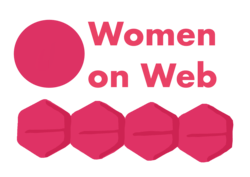Women on Web
Women on Web (WoW) is a Canadian non-profit organization that advocates for and facilitates access to contraception and safe abortion services to protect women's health and lives.[1] People who need access to safe abortion or contraception can have an online consultation at Women on Web website.[2] Women on Web program is a website available in 16 languages, including Arabic, English, French, German, Japanese, Korean, Hungarian, Indonesian, Italian, Persian, Polish, Portuguese, Russian, Spanish, Thai, and Turkish. The organization was founded by Dr. Rebecca Gomperts, a Dutch physician, in 2005.[3]
 | |
| Formation | November 10, 2005 |
|---|---|
| Founder | Rebecca Gomperts |
| Type | Non-profit organization |
| Headquarters | Toronto, Canada |
Region | Worldwide |
| Services | Access to contraception and safe abortion services |
| Website | www |
Research[4] shows that if safe abortions are not available, women will voluntarily risk their health and lives to have unsafe abortions from unqualified persons in unhygienic conditions. Women on Web's goal is to make safe abortion care accessible for all women and pregnant people, free from shame and stigma by providing access to safe telemedicine abortions.
Self-managed medical abortion is done with mifepristone and misoprostol at home before the 9th week of pregnancy.[5] A 2008 study published in the British Journal of Obstetrics and Gynaecology found that women are capable of self‐administering mifepristone and misoprostol at home without a doctor physically visiting them, provided proper information and instructions are given.[5]
Research
Several scientific studies on the outcome of abortions and the experiences of women who have used the Women on Web service have proven that abortion via telemedicine is safe, highly effective and acceptable to women.[6][7][8][9][10] This has been confirmed by the World Health Organization which has recognized that abortions done with the help of Women on Web are considered safe.[11]
Women on Web has also researched data from women in countries where abortion is not legally restricted to highlight the barriers in access to safe abortion services. Research from countries such as the UK, the Netherlands, Hungary and the USA has shown that women face obstacles to access abortion services when these services are only available in clinics or hospitals.[6]
See also
References
- "About Women on Web". 2020-05-29. ISSN 0307-1235. Retrieved 2020-05-29.
- "I need an abortion". Women on Web. 2020-05-29. Retrieved 2020-05-29.
- Grant, Rebecca. "The Website Providing Abortion Without Borders". Retrieved 2018-10-21.
- "Preventing unsafe abortions". World Health Organization. 2020-05-29. Retrieved 2020-05-29.
- Gomperts, Rj; Jelinska, K; Davies, S; Gemzell-Danielsson, K; Kleiverda, G (2008-08-01). "Using telemedicine for termination of pregnancy with mifepristone and misoprostol in settings where there is no access to safe services". BJOG: An International Journal of Obstetrics & Gynaecology. 115 (9): 1171–1178. doi:10.1111/j.1471-0528.2008.01787.x. ISSN 1471-0528. PMID 18637010.
- Abigail R. A. Aiken; Jennifer E. Starling; Alexandra van der Wal; Sascha van der Vliet; Kathleen Broussard; Dana M. Johnson; Elisa Padron; Rebecca Gomperts; James G. Scott (Jan 2020). "Demand for Self-Managed Medication Abortion Through an Online Telemedicine Service in the United States". American Journal of Public Health. 110 (1): 97. doi:10.2105/AJPH.2019.305369. PMC 6893344. PMID 31622157.CS1 maint: multiple names: authors list (link)
- Abigail R.A. Aiken, Kathleen Broussard, Dana M. Johnson, Elisa Padron (11 July 2018). "Motivations and Experiences of People Seeking Medication Abortion Online in the United States". Perspectives on Sexual and Reproductive Health. 50 (4): 157–163. doi:10.1363/psrh.12073. PMID 29992793. S2CID 51615400.CS1 maint: multiple names: authors list (link)
- Les, Krisztina; Gomperts, Rebecca; Gemzell-Danielsson, Kristina (22 Nov 2017). "Experiences of women living in Hungary seeking a medical abortion online". The European Journal of Contraception & Reproductive Health Care. 22 (5): 360–362. doi:10.1080/13625187.2017.1397112. PMID 29164948. S2CID 26216435.
- Abigail R.A. Aiken; Katherine A. Guthrie; Marlies Schellekens; James Trussell; Rebecca Gomperts (September 20, 2017). "Barriers to accessing abortion services and perspectives on using mifepristone and misoprostol at home in Great Britain". An International Reproductive Health Journal Contraception.CS1 maint: multiple names: authors list (link)
- Rebecca Gomperts; Marlies Schellekens; Peter Leusink; Gunilla Kleiverda (6 Nov 2019). "Abortushulp kent te veel barrières".CS1 maint: multiple names: authors list (link)
- Sarah Boseley (27 September 2017). "Almost half of all abortions performed worldwide are unsafe, reveals WHO". Guardian.